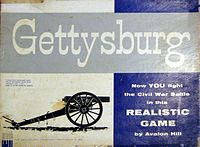
- Tabletop games
- Board games
- Tile-based games
- Turn-based games.html
- Abstract strategy games
- card games
- Connection games
- Mancala games
- Paper-and-pencil games
- Word games



 Gettysburg (1958) by Avalon Hill
|
|
| Players | 2 |
|---|---|
| Age range | 12+ |
| Playing time | 4 to 6 hours |
| Random chance | Medium |
| Skill(s) required | Tactics, strategy |
Gettysburg is a board wargame produced by Avalon Hill which re-enacts the American Civil War battle of Gettysburg.
Gettysburg was originally published in 1958, and was the first board wargame based on a historical battle.
Gettysburg has game mechanics similar to Avalon Hill's ground-breaking Tactics II (1958). In particular, the combat results table favors attacking where one has a local superiority of numbers. Unlike Tactics II, Gettysburg gives each unit an orientation, and an attacker can improve his odds by attacking a defender from the side or from the rear. The defender, meanwhile, can improve his odds by entrenching himself atop a hill.
Charles S. Roberts, the founder of Avalon Hill, made the following comment about the game in 1983:
In its original form, Gettysburg played something like a miniatures game. The map was marked off in a square grid, but this was used for tracking hidden movement, not to regulate regular movement. Movement instead used range cards, which were also used to check firing ranges. The rectangular (not square) units were allowed to rotate on their centers before using the range card, and the system gave bonuses for firing on a flank.
In 1961, the game was re-released, redone to use a hex grid, which also appeared in other Avalon Hill games released that year. This proved a popular mechanism for regulating movement, with it being a staple of wargame design ever since, but Avalon Hill returned to a square grid (albeit with more normal movement rules) for the 1964 edition of the game.
The hex grid returned for the 1977 redesign of the game, which also introduced multiple counters for each unit and expanded rules of unit formation. The rules additions were an attempt to simulate unit movement in columns and the delay and difficulty of changing formation into a line of battle. Separate counters represented flanks, which could be turned to join adjacent units' flanks or turned back to defend against expected assault. Although the grid was retained for the 1988 redesign, the multiple counters per unit and overly complex unit formation rules were discarded, and this last iteration of the game bore a stronger resemblance to the 1961 version, save for the full color illustrated board of the 1977 edition.
A sister game, Chancellorsville, used the same game mechanics.
Lou Zocchi comments: "With Gettysburg, Roberts created a game that evoked memories of brilliant commanders such as Lee and Jackson, even as players grew to understand the intricacies of their commands."
Gary Gygax began playing Gettysburg by December 1958, and Dave Arneson started playing the game in the early 1960s. Gygax and Arneson later designed the seminal role-playing game Dungeons & Dragons in 1974, which grew out of their experience with wargames.